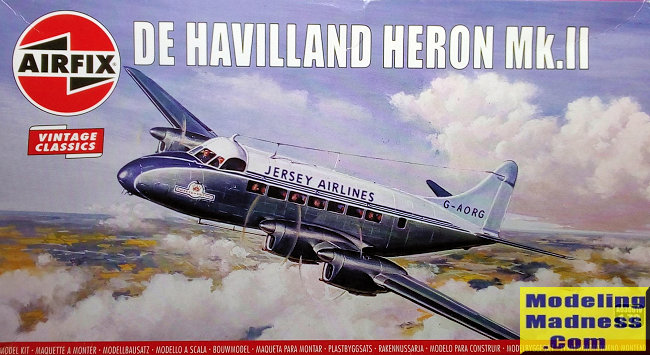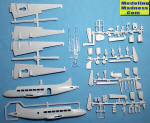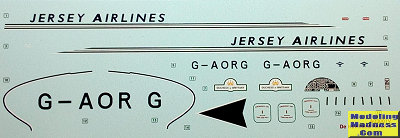
| KIT #: | A03001V |
| PRICE: | €15.00 |
| DECALS: | One option |
| REVIEWER: | Spiros Pendedekas |
| NOTES: |

| HISTORY |
The de Havilland DH.114 Heron is a small propeller-driven British airliner that first flew on 10 May 1950. It was a development of the twin-engine de Havilland Dove, with a stretched fuselage and two more engines. It was designed as a rugged, conventional low wing monoplane with tricycle undercarriage that could be used on regional and commuter routes. A total of 149 were built and it was also exported to about 30 countries. Herons later formed the basis for various conversions, such as the Riley Turbo Skyliner and the Saunders ST-27 and ST-28.
| THE KIT |
 Airfix
first issued this kit in 1959, having reissued it another 4 times ever since.
This kit is the latest 2019 edition. It comes in a small, good quality top
opening box, carrying the same attractive box art with the 1993 edition of a
Jersey Airlines Heron, painted by artist Mike Renwick.
Airfix
first issued this kit in 1959, having reissued it another 4 times ever since.
This kit is the latest 2019 edition. It comes in a small, good quality top
opening box, carrying the same attractive box art with the 1993 edition of a
Jersey Airlines Heron, painted by artist Mike Renwick.
Upon opening the box, I was greeted with 54 light gray styrene pieces neatly
packed in a bag. The fuselage halves are separate, the wing halves are molded in
two pairs, with the rest of the parts arranged in four small sprues. There is
some flash to be cleaned and a few sink marks to deal with, but otherwise the
1959 molds hold on well. Panel lines are mostly raised and of the old style
“rivet” type, tad heavy, but look pleasing to the eye and will possibly look
adequate after some light sanding.
Cockpit is simplistic with just a floor, two seats and an instrument panel, onto
which two good looking decals are to be affixed. Two plots are provided, in case
you want to liven and/or fill up the empty space. Apart from the rear bulkhead,
no passenger interior is provided whatsoever. The side entry door is separate,
but if you attach it “open” the interior will be visible, so its emptiness will
be striking, unless you do something about it. The aerodynamic surfaces are
passable with the ailerons, elevators and fin positionable. The engines are also
adequately looking with separate exhausts. Props look good, as well, though
their thin blades will need careful cleaning from the flash present. Landing
gear is simplified and no wheel wells are provided. A nice touch is the
provision of a boarding ladder, a charming stewardess and another four good
looking passenger figures.
Clear parts are separately bagged and, though thin, look acceptable with the
windscreen containing the cockpit roof. Instructions come in the form of a
4-page folded A3 leaflet, containing a short history of the type, with the
uncomplicated construction spread in 7 clear steps.
 Only one
scheme is provided, for the attractive Jersey Airlines bird depicted in the box
art, with the decals looking superb. The painting instructions come in a
separate glossy A4 sheet, nicely printed in color.
Only one
scheme is provided, for the attractive Jersey Airlines bird depicted in the box
art, with the decals looking superb. The painting instructions come in a
separate glossy A4 sheet, nicely printed in color.
Instructions want you to first assemble the cockpit, attach the side windows
transparencies and then trap the cockpit, the nose wheel, the rear bulkhead and,
equally importantly, 15g of nose weight (in order to avoid tail sitting) between
the fuselage halves, with the side door and tail surfaces following.
The wings are then assembled and attached, followed by the main landing gear installation. The four engines with their props and exhausts come next, continuing with canopy installation, boarding ladder assembly and figures painting and placement, finishing a build that seems relatively simple and straightforward.
| CONCLUSIONS |
With the only other Heron kit I am aware of being the 1/144 FRSIN, if you want a 1/72 Heron, this is the only game in town. Definitely an old mold kit, it seemingly has correct general shape, whereas falls short in details at areas like the cockpit and landing gear, or, worse, the (nonexisting) passenger interior. Parts will need cleanup, but fit is stated to be acceptable, with the build itself looking pleasant and uncomplicated. Instructions are adequate and decals are superb. Some dedicated aftermarket seem to exist, but I could not spot any interior beef-ups, meaning that you will most probably use/modify similar interior bits of other aircraft types or go scratch-building.
Despite being vintage,
the kit can still be turned into a really nice model, with great examples found
in MM archives.
Happy modeling!
May 2022
Copyright ModelingMadness.com. All rights reserved. No reproduction in
part or in whole without express permission.
If you would like your product reviewed fairly and
fairly quickly, please
contact
the editor or see other details in the
Note to
Contributors.